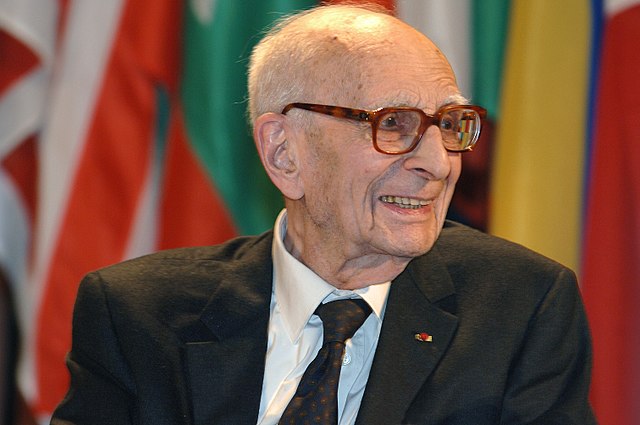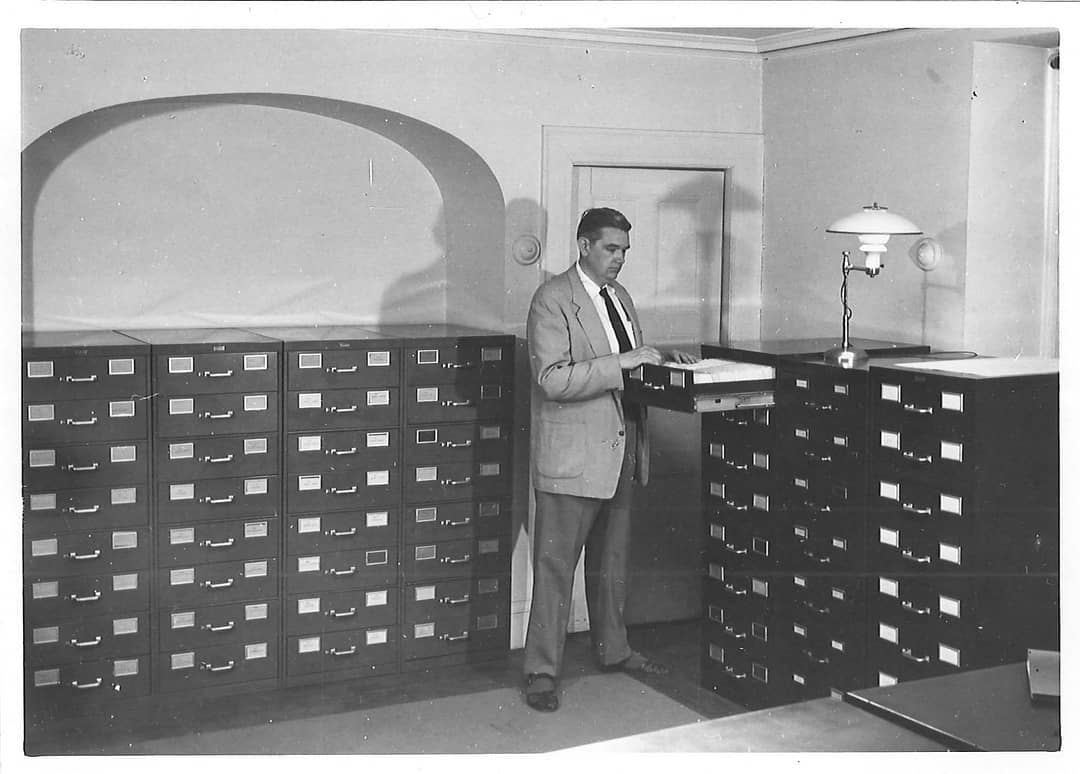By Francine Barone
Editor’s note: The following post contains contributions from Bernadette Bucher, Professor Emerita of Anthropology and Comparative Literature, Fordham University.

Claude Lévi-Strauss. //UNESCO/Michel Ravassard – Transferred from en.wikipedia, CC BY 3.0, Link
The early history of the Human Relations Area Files from 1949 in North America is public record, but the existence and diffusion of the files in Europe in the pre-digital age may not be as well known. How many people would remember that the first and only place where the files could be physically found across the Atlantic was in Paris at the Laboratoire d’Anthropologie Sociale? The lab was created by French anthropologist Claude Lévi-Strauss (1908-2009) at the Collège de France, as soon as he became appointed to the chair of social anthropology in 1960.
In an article about the Human Relations Area Files at the Claude Lévi-Strauss Library, Sandrine Lecointre of the Laboratoire d’anthropologie sociale (LAS) at the Collège de France references the HRAF files as “a laboratory for the study of man” or “a laboratory without walls.” LAS is the only European research site housing the HRAF paper files.
In her obituary for American Anthropologist (2010), Bernadette Bucher, a former student of Lévi-Strauss and now professor emerita of Anthropology and Comparative Literature at Fordham University, mentioned the role that the proponent of “Structural Anthropology” played in housing the files, in the context of his French academic career:
The prestigious chair of social anthropology at the College de France, for instance, was created for him in 1959 according to his own U.S.-shaped views. He immediately established a laboratory, a new concept too, which became a research center for anthropologists previously scattered in different units and provided them with tools and library resources that were not available in France (e.g., the Human Relations [Area] Files [Collection of Ethnography]).
HRAF recently had the pleasure of speaking with Bucher about her experience with the files in what she calls “the lab” of Lévi-Strauss, her mentor, who directed her doctoral dissertation while she was already teaching in New York. She continued to visit him in his office when she was in France and to exchange letters with him until the end of his life. It is in this very office that Bucher conducted an interview with Lévi-Strauss in French, which was subsequently published in her translation in American Ethnologist in 1985.
HRAF’s informal interview with Bucher began with a chance encounter with Ian Skoggard in New York, and followed with a couple of conversations with Matthew Longcore. HRAF asked Bucher what the physical presence of the files meant to her personally and the role it played at different steps of her becoming an anthropologist. We were also curious to know more about the context of the connection between Lévi-Strauss and the files. We hoped to gain some insight into the human and intellectual impact this pre-digital connection and Lévi-Strauss himself may have had on her work as an anthropologist, on both sides of the Atlantic.
Bucher remarked that as a doctoral student, the files were such an essential “tool of the trade” that she assumed any reputable department of anthropology had to have the files in its library. As she learned later, it was in large part thanks to Lévi-Strauss, General Secretary of the International Council of Social Sciences at UNESCO, that France was chosen to be the European center for the files with the provision it should be open to European researchers. The fact that he obtained the privilege of housing the files in his lab was a matter of great pride. It made it the de facto European Center for comparative, cross-cultural ethnographic documentation. This was in accordance with the perspective of Lévi-Strauss, who viewed anthropology as a science, straddling the natural and physical sciences and the humanities.

Before HRAF went digital, member institutions needed special filing cabinets to store our 5″ x 8″ file pages. Some even had whole rooms dedicated to housing the ethnographic info.
Regarding the physical presence of the files, the first thing Bucher remembered was the prominent place these “lofty, greyish, metallic cabinets” occupied on one side of the hallway leading to the office of Lévi-Strauss. At the time, the lab was located in the Collège de France itself, Place Marcelin Berthelot, off the Rue des Écoles, the same street where the Sorbonne stands. According to Bucher, there was an almost sacred aura about these files, symbolizing the collective ethnographic knowledge of the ages – representing both a physical pathway to Lévi-Strauss and an intellectual rite of passage for his students. The physical files were something very special, says Bucher, a vestige of the pre-digital age. One wonders if today’s academic researchers might experience some level of detachment in our world of increasingly paperless scholarship – an interesting and anthropological question, indeed.
When asked about her career and Lévi-Strauss as a teacher, Bucher linked the events of her doctoral, post-doctoral, and professional life to the three different places where the files and the lab moved:
“Actually, the first time I became aware of the HRAF physical presence was not there [at the College de France], but Avenue d’Iéna, in the 16th arrondissement, where the Lab was first located. It was in June 1965, my first appointment with Lévi-Strauss. Over the phone, he had accepted to see me to discuss a possible topic of doctoral dissertation. The Lab at the time occupied what used to be an apartment in a small building. You had to negotiate your way through the labyrinth of these massive filing cabinets to reach the tiny room in which the fortunately slim Levi-Strauss could sit behind a small desk, while he made me sit across from him on a small chair that was half on the threshold of the doorway. You can imagine the emotion I felt! I arrived overprepared, with a list of possible fieldwork sites and issues to explore in Mexico or the Southwest, but he did not want any of it. He had better plans for me: a vast collection of travel to America, the De Bry Collection of 16th and 17th century Voyages, illustrated with splendid engravings of American Indians and the conquest and colonization of the Americas. A topic tailored for me: I could read Latin and German, lived in New York where the NYPL’s rare book room had the best De Brys. He would recommend me to top specialists (e.g. Meyer Schapiro at Columbia, Gilbert Chinard at Princeton). “You’ll do fieldwork afterwards. That would not be the first time an anthropologist starts with library work before going to the field’. And, despite my early protests, that’s indeed what I did and how, instead of studying American Indians in the field, as I dreamed of, I became a Europeanist against my will and beyond his own expectations: As he confessed to me later, he did not think I could do it, namely applying his structural analysis of oral myths to printed, European iconography, and showing that his concept of “pensée sauvage” (wild, undomesticated thought), was a valid concept of unconscious human cognition, whether you were the vanquished American Indians or the European conquerors. When he simply told me: “look at this collection. I’m sure you’ll find something”, he thought that deciphering what these pictures meant in relation to the narratives they illustrated, using Panofsky’s method of iconology, as he suggested, would have been good enough.
As to my fieldwork afterwards, Lévi-Strauss was right. It made so much more sense to choose a site in Europe rather than among American Indians. As I explained in my book Descendants de Chouans, the choice came to me logically: a region of France known mostly to historians because of its counterrevolutionary past, the legendary “Vendée”, especially the “bocage” part, which I knew from childhood. There I could gather contemporary ethnographic data among the descendants of the rebel Chouans, former peasants turned factory workers or entrepreneurs, and confront them with what I collected from local archives going way back before the French Revolution to the 16th century religious wars on the track of the creation and avatars of the woodlands (or Bocage) landscape. Levi-Strauss’ views of anthropology as a holistic science, focusing on relationships among various components or dimensions of empirical world rather than on the components alone, was as useful in the field as in the library. In brief, working through networks of relationships among economic, cultural, geopolitical, and ecological elements and their transformations through four centuries, led to unexpected results, challenging the official version of these historical events, still relevant to contemporary E.U.
Meanwhile, I kept in touch with my French colleagues at the Lab, also involved in what the Journal L”Homme (another Levi-Strauss creation) called “anthropology of the near” (anthropologie du proche) and published my first articles about the Vendée there and in Études rurales, another journal housed in the Lab in the proximity of the Files. This is an aspect of Levi-Strauss’ influence that is not always known on this side of the Atlantic”.
Bucher remembers Lévi-Strauss, whom she describes as her mentor, as a figure of reserve, elegance, and humor. Always treating students with respect, he “made you feel as if you were discussing with a peer”. She remarked that, at times, he was even “disarmingly humble” when asking for advice or references on matters he thought you were knowledgeable about than he was. As a teacher, he was able to simplify the most complex and esoteric of concepts. He was attentive to the minutest of details. Watching him compare the myths from South America to those of the Northern hemisphere with drawings on the blackboard, in the course she took in 1963-1964, taught her how to apply his “transformational” method to quite different materials using HRAF’s files in her own research.
HRAF thanks Bernadette Bucher for her enlightening story about her intellectual journey and how it intersected with Lévi-Strauss.